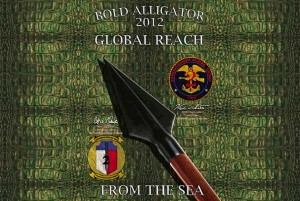
01/31/2012 – The authors of the Pentagon’s new Strategic Guidance must have been reading Second Line of Defense since they affirm many of the arguments made by SLD team. The only problem with the Guidance, which may prove fatal, is that the Pentagon will not receive adequate resources to execute it.
(See the Defense News op ed by Robbin Laird and Ed Timperlake on building agile forces.)
In his recent “2012: Swans Take Flight,” Robbin Laird writes: “U.S. forces need to become more agile, flexible, and global in order to work with allies and partners to deal with evolving global realities. Protecting access points, the global conveyer of goods and services, ensuring an ability to work with global partners in having access to commodities, shaping insertion forces which can pursue terrorist elements wherever necessary, and partnering support with global players all require a re-enforced maritime and air capability. This means a priority for the USCG, USN, USMC and the US Air Force in the re-configuring effort. Balanced force structure reduction makes no sense because the force structure was re-designed for land wars that the US will not engage in the decade ahead.” (See also, http://defense.aol.com/2012/01/03/whack-old-weapons-rebuild-the-army-or-fade-from-view/.)
According to the new U.S. Defense Strategic Guidance, dramatically released on January 5 at a Pentagon news conference opened by President Obama, the international order has reached a strategic inflection or turning point.

With the end of the wars in Iraq and Libya, and the impending U.S. military withdrawal from Afghanistan, the United States can now adjust its force posture and other resources to better address new geographic (China rather than Iraq) and functional (anti-access rather than transnational terrorism) challenges.
The United States will therefore realign military resources to address these concerns. This shift in geographic focus will also require the U.S. military to strengthen capabilities for missions other than counterterrorism and counterinsurgency, especially global deployment and insertion capabilities.
The new strategic environment offers the Pentagon an opportunity to rebalance its portfolio of missions and capabilities as well as their geographic concentration. The Department is wise to get ahead of the budget cutting process now, using the Guidance as justification to cancel some legacy programs and scale back others, before outsiders impose more arbitrary cuts—as will occur in January 2013 if congressional sequestration occurs.
According to Panetta, the Guidance was written in conformity with four over-arching principles:
1)”we must maintain the world’s finest military”
2) “we must avoid hollowing out the force — a smaller, ready, and well-equipped military is much more preferable to a larger, ill-prepared force that has been arbitrarily cut across the board” (as threatened for January 2013 by congressional sequestration)
3) “savings must be achieved in a balanced manner, with everything on the table, including politically sensitive areas”; and
4) “we must preserve the quality of the all-volunteer force and not break faith with our men and women in uniform or their families.”
Panetta further explained at the news conference rolling out the new strategy posits several major changes in the Defense Department’s direction:
1) The joint force envisaged for 2020 will be smaller and leaner but also “more agile, more flexible, ready to deploy quickly, innovative, and technologically advanced.”
2) The Department is also “rebalancing our global posture and presence” with a new “institutional weight and focus on enhanced presence, power projection, and deterrence” in the Asia-Pacific region while “maintaining our military presence and capabilities in the broader Middle East.
3) “the United States will continue to strengthen its key alliances, to build partnerships and to develop innovative ways to sustain U.S. presence elsewhere in the world,” with a special emphasis on developing innovative ways to maintain a security presence with fewer resources in the other world’s other regions.
4) The Pentagon will maintain “the capability to fight several conflicts at the same time” in partnership with other countries, which will have greater responsibility for defending their national territories.”
5) The Department will reduce the size of the Army and Marine Corps while preserving and sometimes increasing “investments in special operations forces, in new technologies like ISR and unmanned systems, in space — and, in particular, in cyberspace –capabilities, and also our capacity to quickly mobilize if necessary.”
6) Even while making reductions the Department will “ensure the capacity to surge, regenerate and mobilize capabilities needed for any contingency” by, among other measures, “re-examining the mix of elements in the active and reserve components…and preserving the health and viability of the nation’s defense industrial base.”

Deputy Secretary of Defense Ashton Carter insisted at the roll out that the Department would not “simply revert to yesterday’s pre-9/11 force structure under the pressure of budget cuts.” Adm. James A. Winnefeld Jr., Vice Chairman of the Joint Chiefs of Staff, argued that the administration avoided the standard practice of simply applying proportional reductions across the board. Instead, the administration sought to determine what strategy it would need to address the emerging global security environment and then resourced the capabilities required to execute the strategy.
The authors’ explicit intellectual modesty, manifested in the “hedging” underpinning the Strategic Guidance, should also be applauded. The Guidance presumes a general continuity of contemporary global security trends, but the Pentagon understands that a Black Swan could easily arise that would leave the United States vulnerable if the Pentagon could not rapidly recover and respond. “Given that we cannot predict how the strategic environment will evolve with absolute certainty, we will maintain a broad portfolio of military capabilities that, in the aggregate, offer versatility across the range of missions described above.”
In terms of preserving old and developing new capabilities, Pentagon leaders made clear that they want a responsive capability for rapid regeneration and reversibility. The Guidance directs that, “ DoD will manage the force in ways that protect its ability to regenerate capabilities that might be needed to meet future, unforeseen demands, maintaining intellectual capital and rank structure that could be called upon to expand key elements of the force.” Furthermore, the Guidance adds that,” the concept of .“reversibility.” .– including the vectors on which we place our industrial base, our people, our active-reserve component balance, our posture, and our partnership emphasis .– is a key part of our decision calculus.”
In his Pentagon briefing, Carter affirmed that, as it made the $487 billion worth in mandated cuts in force size and capabilities, “we want to, to the extent we can do so, preserve the ability to change course.” Carter cited the need to preserve the skills and knowledge the Department gained in waging the unexpected counterinsurgencies in Afghanistan and Iraq, to retain a sufficiently large cadre of mid-grade and skilled noncommissioned officers to have the middle management available to support a larger force structure, such as mobilized Reserve Components, if one proved necessary. “We can’t afford to do that comprehensively,” Carter acknowledged, “but we can afford to do some of that.”
The United States has long sought to reduce military personnel while compensating through endowing the remaining forces with more advanced technologies to make them more effective. Indeed, the current Strategic Guidance reads very much like something former Secretary of Defense Donald Rumsfeld would have issued before the wars in Afghanistan and Iraq distracted him from his planned transformation of the Department into Defense 2.0 through “networked warfare” capabilities, which would create a seamless linkage among omniscient U.S. units who would rely on superior knowledge and integration to overcome more numerous opponents.
The anti-access and area-denial capabilities and strategies increasingly available to potential adversaries discussed in the Guidance have already been driving the U.S. interest in stealth, speed, and stand-off launching power projection capabilities.
In addition to current Iranian threats to close the Strait of Hormuz, a major Pentagon worry is China’s development of the Dong Feng 21D anti-ship ballistic missile, anti-satellite weapons, cyber strike capabilities, emerging long-range precision strike systems, and other technologies. The Guidance therefore directs that “the U.S. military will invest as required to ensure its ability to operate effectively in anti-access and area denial (A2/AD) environments.
(For a look at how the integration of the F-35 and Aegis systems will shape such capabilities see “Winning the Air-Sea battle” or “The Long Reach of Aegis”.)
This will include implementing the Joint Operational Access Concept, sustaining our undersea capabilities, developing a new stealth bomber, improving missile defenses, and continuing efforts to enhance the resiliency and effectiveness of critical space-based capabilities.
The Joint Operational Access Concept and the planned capability enhancements to U.,S. forces seek to ensure that military that U.S. commanders can overcome sophisticated A2/AD strategies that employ both technical and nontechnical capabilities and methods. The Concept roughly distinguishes between the two by their distance. Adversaries employ “anti-access” (A2) strategies aim to impede U.S. use of global commons and U.S. international power projection by using such capabilities as satellites, cruise and ballistic missiles, cyber weapons, counter-space systems, and even well-placed terrorists and paramilitaries. “Area denial” (AD) capabilities such as air defenses; precision guided weapons, mines, weapons of mass destruction, and innovative irregular tactics seek to prevent or disrupt U.S. efforts from establishing an operating presence in or near an adversary.
Panetta and other officials acknowledge certain risks with the Guidance. Its success could depend on the timely mobilization of the Reserve Components, the timely development and application of advanced technologies, and the increased U.S. reliance on foreign partners. Above all, there is risk in making reductions now in DoD strength and spending when, unlike in the past, the major threats to the United States that originally caused the U.S. defense buildup have not going away.
Yet, critics are incorrect when they charge that, “The administration’s focus on Asia-Pacific and reduction of ground forces in favor of air and naval forces are both manifestations of what the late political scientist Samuel P. Huntington called ‘strategic monism’, the domination of defense policy by a single strategic concept or regional focus.” Both the Guidance and the statements of the key members of the administration call for with retaining a variety of forces and weapons in being to counter diverse potential threats or at least the capacity to regenerate the needed forces rapidly when needed.
The problem is rather that the Pentagon might not fight hard enough in Congress to provide all the forces needed to respond across the entire spectrum of conflict to counter major threats to the United States wherever they might arise. According to Carter’s calculations, the White House has already told the Department that it must chop $489 billion from its base budget during the next ten years, of which $263 billion must be cut in the next five years. The Department’s supplementary budgets are also shrinking due to its decreased overseas contingency operations. The combined effect of these two processes is that “you have over the next four years a reduction in total defense spending as rapid as any we experienced after Vietnam or after the Cold War.”
Certain measures could reduce these risks, beginning with ensuring support for needed capabilities in the FY 2013 budget, which the administration will send to Congress in the next week or two.
First, the Guidance focuses too much on developing a new stealth bomber and underestimates the way in which the existing and growing USAF F-35 fleet can negate Chinese and Iranian anti-access and area-denial capabilities and strategies. The vastness of the Asia Pacific theater makes having robust military air and naval assets especially important. The F-35, along with the F-22, will prove essential for allowing the U.S. Air Force to counter the new Chinese J-20 stealth fighter and other PLA Air Force warplanes.
The administration needs to make a stronger effort to reach out to allies.
At the international level, working with foreign governments is essential since the United States lacks the means to address all challenges by itself. Maybe the United States cannot purchase all the F-35s the Pentagon needs, but the damage can be limited if U.S. allies make up any shortfalls through their own purchases. The Australian and Japanese air forces and other U.S. Asian allies also plan to acquire the F-35, which will enhance interoperability between the U.S. military and its regional allies. (See http://defense.aol.com/2011/12/22/f-35-will-revolutionize-air-combat-power-in-the-pacific/ and http://defense.aol.com/2011/11/16/a-new-strategic-moment-for-darwin-and-australia/.)
In the Gulf, the Pentagon will need to rely more on Saudi Arabia and other Gulf Cooperation Council members to purchase missile defenses, sophisticated warplanes, and other means to help the Pentagon counter Iran.
In addition, enhancing U.S. capabilities in the Asia-Pacific region will require increases in the resources flowing to the Navy and Air Force since they are best capable of managing the large distances in that theater. Having Marines in Australia is nice, but they still need to be able to move rapidly to where their deterring or combat presence is needed, which will most likely be closer to the Asian mainland. As Panetta acknowledged to PBS Newshour, “you’re not going to have that large a presence throughout the world. And so we are going to have to be much more agile, much more flexible in moving forces around.” Most Asian-Pacific countries would not welcome a large U.S. troop presence on their soil, even on a rotational basis.
The Pentagon plans to rely heavily on the National Guard and Reserves as ready mobilization forces should a manpower surge become necessary. As Panetta acknowledged in an interview on National Public Radio, “If we are dealing with a leaner and meaner force, if we have to mobilize, there’s only one place to go — and that’s to the National Guard and to our Reserve units.” But then these Reserve Components need to be adequately resourced and its members need to understand they are joining an operational rather than a strategic reserve, even if they no longer need to rotate to Afghanistan and Iraq every few years.
In his forward to the Guidance, President Obama rightly notes the importance of adopting a whole-of-government approach that treats diplomacy, development, intelligence, and other non-military instruments as national security tools. DoD leaders understand that, due to the weakness of these non-military tools, the White House will often turn to the military to the Pentagon address an issue since, while military power might not be the most appropriate means to solve a problem, it is better resourced and often more easy to use overseas than the other instruments of national power. But then the administration and especially Congress needs to fund them accordingly.
The State Department in particular will need to fill the gap resulting from a smaller U.S. military presence in many regions. In welcoming the new Guidance, Secretary of State Hillary Clinton observed that, “As the new strategy notes, meeting our challenges cannot be the work of our military alone. Diplomacy and development are equal partners with defense in our smart power approach to promoting American interests and values abroad, building up our economic prosperity, and protecting our national security.”
Maintaining a healthy U.S. defense industrial base is also important for assuring U.S. technological superiority in future military conflicts. The Defense Department must continue to modernize the force selectively in line with emerging threats, technologies, and resources. Experimentation, simulation, and exercises can help determine the most promising upgrades. In addition to fielding better weapons platforms, DoD should also strive to make U.S. command, control, and other information processes less vulnerable and more effective.
For our approach to building scalable forces see our Special Report on the Pacific.
The featured image: PATUXENT RIVER, Md. (Jan. 20, 2012) Secretary of Defense Leon E. Panetta is shown the Joint Strike Fighter Manned Flight Simulator by Lieutenant Colonel (USMC) Fed “Tinman” Schenk at Naval Air Station Patuxent River, Maryland. Secretary Panetta toured several facilities related to the F-35 Joint Strike Fighter. The F-35B has moved from a test to training phase at Eglin AFB.
http://www.navy.mil/management/photodb/photos/120120-D-BW835-003.jpg

